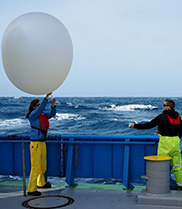Investigator completes Antarctic cold water trials
The Executive Director of the project to build and test the vessel, Toni Moate said the voyage to the ice-edge tested out key capabilities of the ship, to ensure the vessel can operate in low water temperatures.
The ship has been designed to operate in water temperatures of -2ºC to +32ºC, from the Antarctic ice edge to the tropics.
“On this cold water commissioning voyage we tested everything from the winches to the dynamic positioning system, to make sure they were operational in very cold conditions,” Ms Moate said.
The voyage left Hobart in late January and returned this week. Work that occurred on board included:
- Commissioning equipment in the Atmospheric and Air Chemistry Laboratories. Investigator is the first Australian research vessel to have laboratories dedicated to collecting aerosol data.
- Testing and opportunistic seafloor and sub-seafloor sonar mapping in areas not previously surveyed.
- Testing and opportunistic gravity meter readings, which will improve understanding of the crustal structure of the region.
- Operating on-deck scientific equipment handling systems such as winches, A-Frame, coring boom and CTD boom.
- Operating communications systems and video conferencing live from the ice-edge.
- Testing cold water survival and ship manoeuvring systems.
One of the Marine National Facility’s Operations Officers, Max McGuire, was on board for the voyage.
“It’s the most southerly voyage any Marine National Facility vessel has ever travelled, so everyone was really excited to reach the 65 degree south line, which is around 90 nautical miles from the Antarctic continent,” Mr McGuire said.
On board were scientists from the Queensland University of Technology, Melbourne University, CSIRO and the University of Wollongong, who were testing atmospheric research capabilities and equipment.
Under direction of an independent Steering Committee, the Marine National Facility is owned and operated by CSIRO on behalf of the nation.
Investigator’s first research voyage is scheduled to leave Hobart on 22 March to deploy deep sea oceanographic moorings in the Southern Ocean.
The voyage is a collaboration between the Antarctic Climate and Ecosystems Cooperative Research Centre, the Integrated Marine Observing System, the Australian Bureau of Meteorology and the University of Tasmania’s Institute for Marine and Antarctic Studies, and will be led by CSIRO’s Professor Tom Trull.
Media resources
Click image for high resolution version

